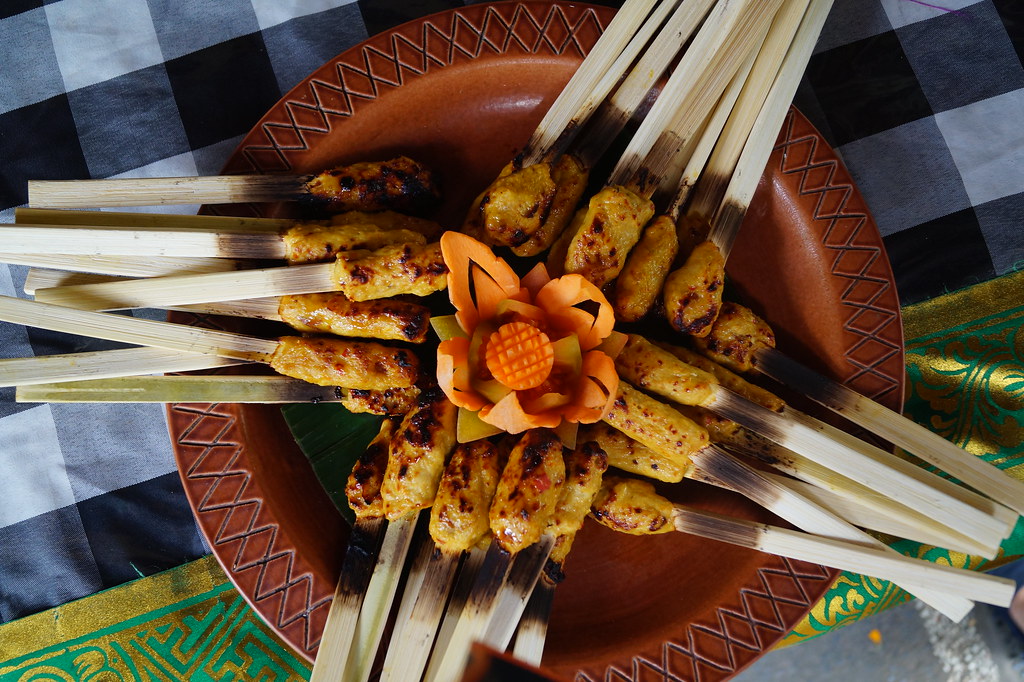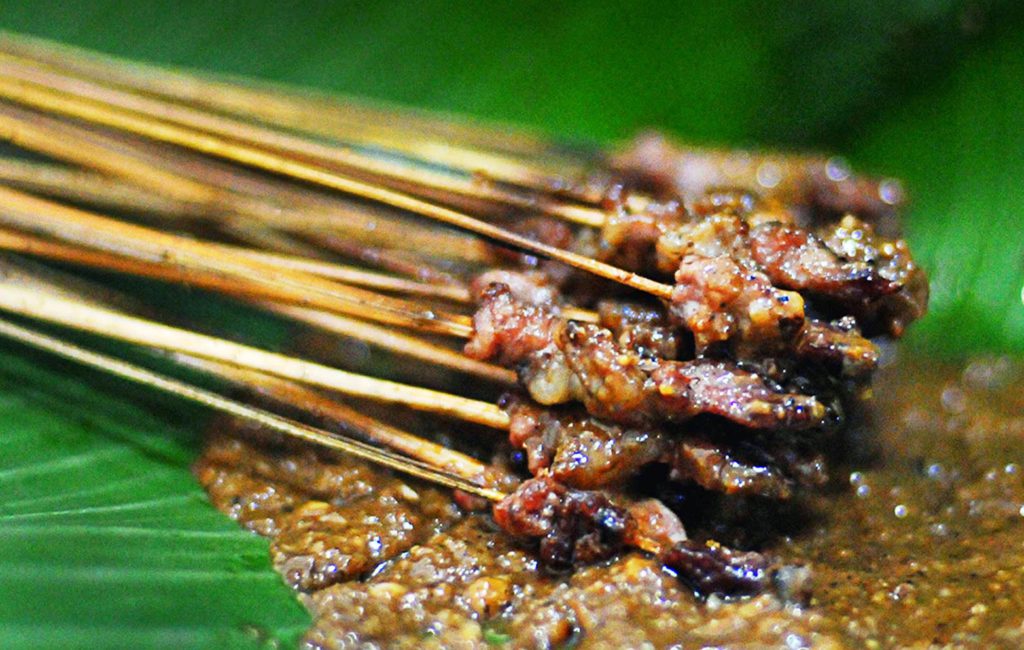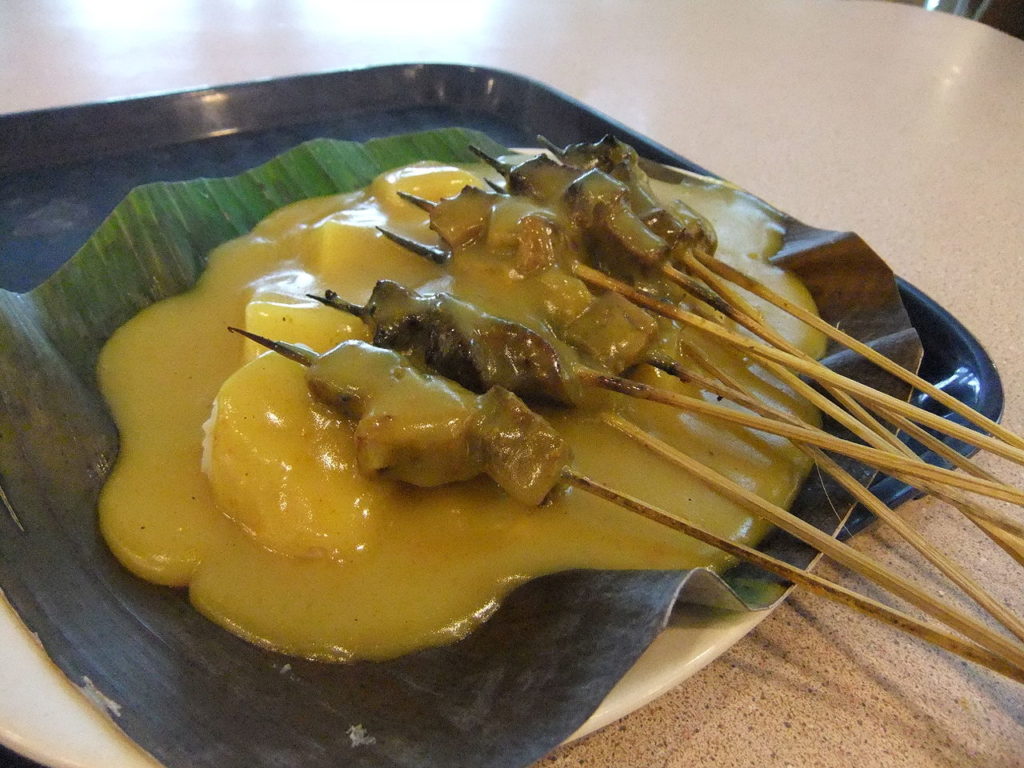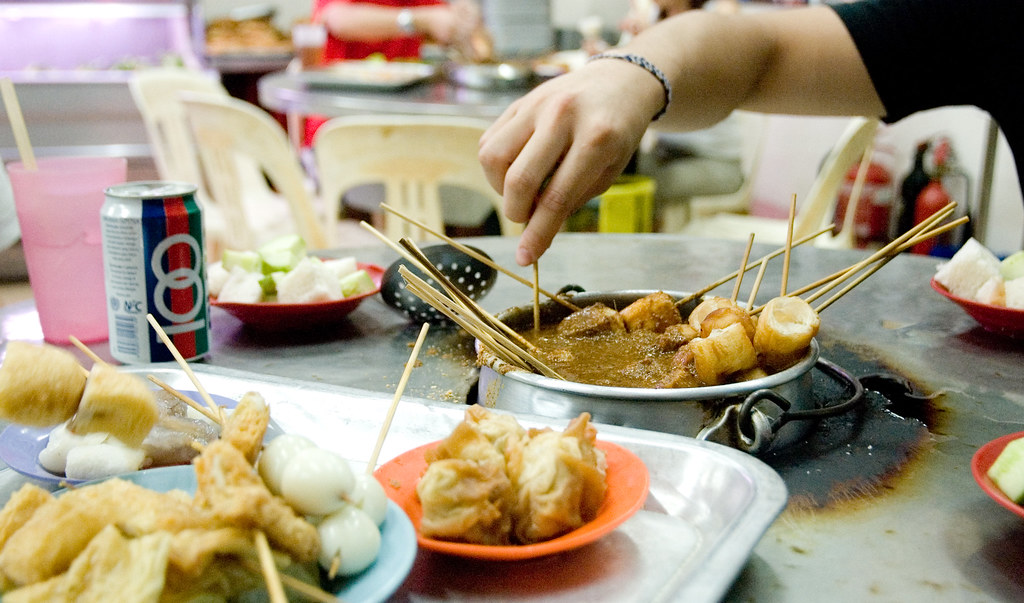1. Sate lilit
The word lilit means “to wrap” in Indonesian, a reference to the way Balinese sate lilit – a meaty paste wrapped around a lemongrass stalk – is prepared.
To make the paste, minced meat (typically pork) or seafood like fish and prawn is combined with ground shallots, galangal, turmeric, coriander seeds, kaffir lime leaves, grated coconut, salt and palm sugar.
 The mixture is then pressed around lemongrass batons that lend their citrusy fragrance to the meat as the skewers are gently grilled over smoking hot charcoal.
The mixture is then pressed around lemongrass batons that lend their citrusy fragrance to the meat as the skewers are gently grilled over smoking hot charcoal.
Sate lilit is best enjoyed dunked in kecap manis (sweet soya sauce) with chopped chillies, or paired with sambal matah, a spicy condiment made with chillies, garlic, lemongrass and lime juice.
2. Sate Madura
Hailing from the Indonesian island of Madura, off the northeastern coast of Java, sate Madura is famed for its luscious sauce featuring peanuts, aromatics, terasi (shrimp paste) and petis udang, a sweet and pungent shrimp paste with a molasses-like consistency.
Chicken is the preferred protein for this satay, followed by beef and mutton.
 The skewered meat is first brushed with kecap manis and grilled until almost cooked. Then, the meat is basted with the pre-cooked peanut sauce and left on the grill to finish.
The skewered meat is first brushed with kecap manis and grilled until almost cooked. Then, the meat is basted with the pre-cooked peanut sauce and left on the grill to finish.
The satay may be served with more peanut sauce or a drizzle of kecap manis and a sprinkling of chopped chillies and onion, and is usually savoured with lontong (compressed rice cakes).
3. Sate Padang
Sate Padang comes from the Minangkabau culinary heritage, where coconut milk and chillies are used liberally.
Unlike its other Indonesian cousins, sate Padang features chunks of beef (brisket, flank or sirloin) and offal that are marinated and twice-boiled to ensure tender and juicy morsels of meat.
The beefy broth that the meat has been cooked in is re-used to make a thick curry-like sauce seasoned with aromatics and spices like fennel, coriander and turmeric root, and spiked with chillies.
 The satay is grilled over smoking hunks of coconut husks instead of charcoal briquettes, which provides a consistent heat for evenly cooked meat.
The satay is grilled over smoking hunks of coconut husks instead of charcoal briquettes, which provides a consistent heat for evenly cooked meat.
To serve, a ladling of the spicy curry sauce is poured atop the cooked skewers of meat and sprinkled with sliced shallots deep-fried to a crisp.
4. Satay celup
This satay originates from the Malaysian state of Melaka, where skewers of raw or partially cooked meat, seafood, tofu and vegetables are boiled in flavourful satay broth rather than grilled.
This is done by dipping the skewers (celup means “to dip” in Malay) in the bubbling broth provided, similar to a Chinese chuan chuan hotpot or fondue.
 The spicy brew consists of a blend of ground peanuts, shallots, lemongrass, galangal, red chillies, candlenuts and spices.
The spicy brew consists of a blend of ground peanuts, shallots, lemongrass, galangal, red chillies, candlenuts and spices.
Most customers will attest that the fun is in the cooking. Just choose the ingredients you want from the mind-boggling selection that can also include boiled quail eggs, shelled cockles and Chinese crullers, dip them in the boiling pot and enjoy.
5. Sate hati kura
Owing to shared culinary traditions with neighbouring Malaysia and Indonesia, satay is also one of the most popular street foods in the tiny, oil-rich kingdom of Brunei.
But aside from the usual chicken and beef skewers, in Brunei, the rare sate hati kura is a sought-after specialty. Hati kura literally means “tortoise liver” in Malay, but this satay has nothing to do with the shelled reptiles.
It is, in fact, made from iron-rich cow or buffalo spleen that is typically boiled for about two hours to tenderise it and remove any impurities.
Before grilling, the meat is sliced and marinated for at least half an hour with a spice paste that includes blended aromatics.
Bruneians enjoy their satay with a spicy-sweet peanut sauce, nasi impit (compressed rice cakes) and kelupis, or steamed glutinous rice rolls made with coconut milk and palm sugar wrapped in daun nyirik (Phacelophrynium maximum leaves).
You’ll most likely find this satay at the popular Gadong Night Market in the capital, Bandar Seri Begawan.
6. Satti
Who doesn’t like a good barbecue? In Zamboanga, Philippines, the grilled item of choice are beef skewers called satti.
The name of the dish suggests its relation to satay, with the only difference being the absence of the popular peanut dipping sauce enjoyed in Malaysia, Singapore and Brunei, and parts of Indonesia and Thailand.
Instead, satti showcases a coconut milk-rich sauce redolent with spices and annatto, a nutty and peppery condiment that tinges the broth orange.
To make the sauce, diced tomatoes, onions, ginger, turmeric and chillies are sauteed and blitzed into a paste, then added to simmering coconut milk with a pinch of shrimp paste.
To add depth, colour and texture, cornflour, plain flour, brown sugar and annatto powder are mixed with water and added to the sauce.
The barbecued beef skewers are served with a bowlful of the sauce and puso, sticky rice cakes steamed in woven coconut leaves, similar to Malaysian ketupat.
According to airasia.com













